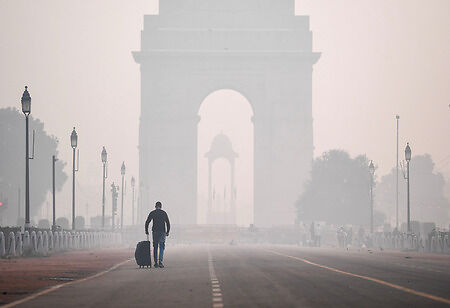
To Clear Air Pollution, We Must Get Clear With Nitrate Radical Production Process


According to a recent study published in Nature Geosciences, certain regions of China and India are nighttime hotspots for the generation of nitrate radicals that could increase the amount of harmful ozone and PM2.5 small particulate matter in the atmosphere. Nonetheless, nitrogen oxides can affect how biogenic volatile organic compounds (BVOC) oxidize, particularly when they interact photochemically with organic and hydroperoxy radical intermediates (RO2 and HO2) (NO).
Cities in Europe and the US have seen a decrease in the amount of nitrate radicals produced at night, whereas portions of China and India have seen a sharp rise.
The burning of fuel is the main source of NO2 in the atmosphere. NO2 is created as a result of emissions from automobiles, trucks, buses, power plants, and off-road vehicles.
According to the study, even if NO2 emissions are reduced, nighttime oxidation in China will continue to rise if recent rising ozone pollution patterns continue. The study showed that the production of nitrate radicals rises at night in some regions of India, particularly northern India. It will be more challenging for India to improve air quality in the future if it adopts Los Angeles and China-style practices.
The study emphasizes that if we are to develop effective global pollution mitigation strategies and comprehend the impact of nitrogen oxides on air quality and climate, we must better grasp the vital but little understood process of nocturnal oxidation driven by nitrate radicals.
Effects on Agriculture
Nitrogen oxides are known to harm plant cells directly. Additionally, they contribute to the generation of aerosols in the atmosphere that block sunlight, which is necessary for photosynthesis and the harmful chemical ozone, which lowers crop yields. According to the analysis, which was published in Science Advances, halving NOx emissions may increase China's winter crop yields by roughly 25 percent and summer crop yields by 15 percent. For summer and winter crops, respectively, the improvement in crop productivity in India might be eight percent and six percent.
Effects of Nitrogen Oxides on Human Health
Valves in the human respiratory system might become affected when breathing air with a high NO2 concentration. Such brief exposures might worsen respiratory illnesses, especially asthma, resulting in respiratory symptoms (such coughing, wheezing, or difficulty breathing), hospital admissions, and ER visits. Longer exposures to high NO2 concentrations may raise the risk of developing asthma as well as make people more susceptible to respiratory infections. Children, the elderly, and those with asthma are typically more vulnerable to the negative health consequences of NO2.
What it does to the Environment
Acid rain is caused when NO2 and other NOx in the atmosphere combine with water, oxygen, and other compounds. Sensitive habitats, such lakes and forests, are harmed by acid rain.
It makes the air foggy and difficult to see due to the nitrate particles that NOx produces. The numerous national parks that we visit for the scenery are impacted by this.
What is Being Done to Reduce NO2 Pollution
The Clean Air Act, which was last revised in 1990, mandates that the EPA establish National Ambient Air Quality Standards (40 CFR part 50) for six major pollutants (also known as criteria air pollutants) that have the potential to affect both the environment and public health. Two categories of national ambient air quality criteria are listed in the Clean Air Act. Primary standards protect the public's health, including vulnerable populations including children, the elderly, and people with asthma. Secondary standards safeguard the general public's welfare by guarding against things like reduced visibility and harm to animals, crops, plants, and structures.
State and local governments will be aided in meeting the NAAQS by the EPA's national and regional regulations to reduce NO2 and NOx emissions.
Areas where the air quality does not satisfy the federal NO2 requirements are identified by EPA. State, local, and tribal governments create plans to lessen the amount of NO2 in the air for these places.
Maximum NO2 levels allowed in outdoor air are set by NAAQS for NO2. The environment and human health are both protected when NO2 levels are kept low.
More recently last year, the EPA strengthened the health-based NAASQ for NO2.
The 1-hour standard will safeguard the public's health by reducing exposures to NO2 short-term peak concentrations, which are most common close to major highways. NO2 concentrations in the entire community will be kept below those that have been associated with respiratory-related ER visits and hospital admissions.
EPA also set guidelines for reporting and monitoring NO2 in ambient air. Monitors are necessary in metropolitan areas along busy roadways and other places where highest concentrations are anticipated. To help safeguard communities that are vulnerable to NO2-related health consequences, EPA has put a number of monitors in strategic areas.
In addition, there are numerous activities that each citizen can take to lessen their exposure to or contribution to NO2.
Self NO2 Reduction Measures
Maintain autos properly, paying particular attention to tire pressure.
- When feasible, carpool, walk, cycle, or take public transportation.
- Purchase automobiles with low exhaust emissions and excellent fuel efficiency.
- When parked in a drive-through lane at a restaurant or a bank or while waiting to pick up your kids from school, turn off the engine to prevent idling. Combine tasks and stay away from early starts.
- To cut down on emissions from energy production, lower your household's energy use by turning off lights, televisions, and other appliances when not in use. In the winter, lower your thermostat setting; in the summer, higher.